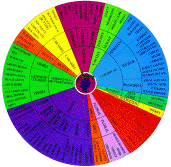Tasting on the Wheel
We actually smell most of the things that we think we taste, or so the scientists say.
Our poor taste buds can discern only four flavors - sweet, sour, salt and bitter - while our noses are capable of distinguishing thousands of subtle variations.
If you like wine and catch a cold, you're well advised to switch to soft drinks, pure spring water or something equally undemanding until the sniffles have passed and you can again enjoy the olfactory nuances that make wine something special.
The wines of the world offer thousands of scents in their almost infinite variety. I must have smelled a few hundred things in wine myself, ranging from the commonplace (grapes and fruit) to the off-the-wall (sawdust and asparagus) and the disgusting (dirty socks and wet dog fur).
 As an aid to novice wine tasters - and experts too - the wine
scientists at the University of California at Davis, one of the nation's
leading wine-making and grape-growing schools, came up years ago with
something called the "aroma wheel."
As an aid to novice wine tasters - and experts too - the wine
scientists at the University of California at Davis, one of the nation's
leading wine-making and grape-growing schools, came up years ago with
something called the "aroma wheel."
The oenologists at Davis consulted with scores of wine lovers and wine tasters to list all the descriptive terms they could imagine for the smells of wine. Then they organized them, categorized them, eliminated all that seemed ambiguous or less than clear, and ended up with a list of 12 major categories of wine smells, subdivided into 29 subcategories and in 94 specific terms.
The original "wheel" was so called because it was displayed as a circular table, with relatively similar smells placed close together around its circumference. (Colored plastic laminated copies of the wine aroma wheel may be obtained from A.C. Noble, Dept. Vit. & Enology, Univ. California, Davis, Calif 95616.) The wheel can be viewed on the UCDavis Website.)
You don't need a wheel to get rolling, however: The information is just as useful in the form of a list, starting at noon and moving around the clock from "fruity" through "nutty" and "earthy" around to "floral," "spicy" and back to fruity again.
If you want to get more out of your wine, try your next tasting session with the list at hand, scanning the categories in search of the exact word to describe what you're smelling.
I think you'll be surprised to see how a glance at the "wheel" helps your thoughts snap into focus.
I've edited the following list somewhat to save space, leaving out some of the more obscure and technical terms, but you'll find all the usual aromas rounded up here:
FRUITY: Citrus - grapefruit, lemon; berry - blackberry, raspberry, strawberry, black currant (cassis); tree fruit - cherry, apricot, peach, apple; tropical fruit - pineapple, melon, banana; dried fruit - strawberry jam, raisins, prune, fig.
VEGETATIVE: fresh - stemmy, cut green grass, bell pepper, eucalyptus, mint; canned-cooked - green beans, asparagus, green olive, black olive, artichoke; dried - haw-straw, tea, tobacco.
NUTTY: walnut, hazelnut, almond.
CARAMELIZED: honey, butterscotch, butter, soy sauce, chocolate, molasses.
WOODY: vanilla, cedar, oak, smoky, burnt toast, charred, coffee.
EARTHY: dusty, mushroom, musty (mildew), moldy cork.
CHEMICAL: petroleum - tar, plastic, kerosene, diesel; sulfur - rubbery, garlic, skunk, cabbage, burnt match, wet wool, wet dog; papery - wet cardboard; pungent - acetic acid (vinegar); other - soapy, fishy.
PUNGENT: hot - alcohol; cool - menthol.
MICROBIOLOGICAL: yeast, sauerkraut, sweaty, horsey, "mousey."
FLORAL: orange blossom, rose, violet, geranium.
SPICY: cloves, black pepper, licorice, anise.
Use the "wheel" as a guide when you're tasting wine for fun, and I think you'll be surprised to see how well this list of descriptive terms will help you recognize those elusive characteristics.
This brings our quick online wine course to a conclusion. If you'll remember two simple rules - (1) think about wine, and (2) keep opening bottles - you'll soon be on your way to expertise and a lifetime of enjoyment. Good luck, and good wine!




